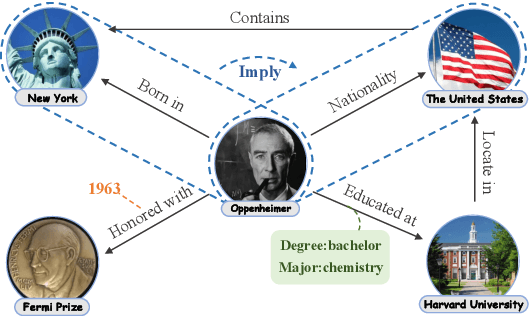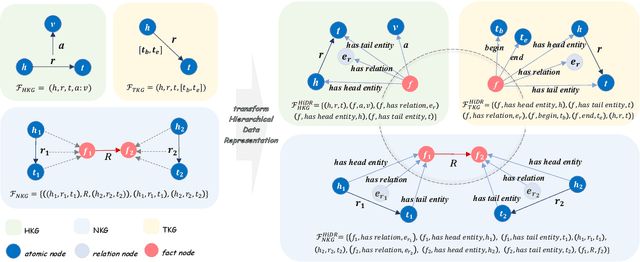Lei Liang
LookAhead Tuning: Safer Language Models via Partial Answer Previews
Mar 24, 2025Abstract:Fine-tuning enables large language models (LLMs) to adapt to specific domains, but often undermines their previously established safety alignment. To mitigate the degradation of model safety during fine-tuning, we introduce LookAhead Tuning, which comprises two simple, low-resource, and effective data-driven methods that modify training data by previewing partial answer prefixes. Both methods aim to preserve the model's inherent safety mechanisms by minimizing perturbations to initial token distributions. Comprehensive experiments demonstrate that LookAhead Tuning effectively maintains model safety without sacrificing robust performance on downstream tasks. Our findings position LookAhead Tuning as a reliable and efficient solution for the safe and effective adaptation of LLMs. Code is released at https://github.com/zjunlp/LookAheadTuning.
When Large Vision-Language Model Meets Large Remote Sensing Imagery: Coarse-to-Fine Text-Guided Token Pruning
Mar 10, 2025Abstract:Efficient vision-language understanding of large Remote Sensing Images (RSIs) is meaningful but challenging. Current Large Vision-Language Models (LVLMs) typically employ limited pre-defined grids to process images, leading to information loss when handling gigapixel RSIs. Conversely, using unlimited grids significantly increases computational costs. To preserve image details while reducing computational complexity, we propose a text-guided token pruning method with Dynamic Image Pyramid (DIP) integration. Our method introduces: (i) a Region Focus Module (RFM) that leverages text-aware region localization capability to identify critical vision tokens, and (ii) a coarse-to-fine image tile selection and vision token pruning strategy based on DIP, which is guided by RFM outputs and avoids directly processing the entire large imagery. Additionally, existing benchmarks for evaluating LVLMs' perception ability on large RSI suffer from limited question diversity and constrained image sizes. We construct a new benchmark named LRS-VQA, which contains 7,333 QA pairs across 8 categories, with image length up to 27,328 pixels. Our method outperforms existing high-resolution strategies on four datasets using the same data. Moreover, compared to existing token reduction methods, our approach demonstrates higher efficiency under high-resolution settings. Dataset and code are in https://github.com/VisionXLab/LRS-VQA.
Every FLOP Counts: Scaling a 300B Mixture-of-Experts LING LLM without Premium GPUs
Mar 07, 2025



Abstract:In this technical report, we tackle the challenges of training large-scale Mixture of Experts (MoE) models, focusing on overcoming cost inefficiency and resource limitations prevalent in such systems. To address these issues, we present two differently sized MoE large language models (LLMs), namely Ling-Lite and Ling-Plus (referred to as "Bailing" in Chinese, spelled B\v{a}il\'ing in Pinyin). Ling-Lite contains 16.8 billion parameters with 2.75 billion activated parameters, while Ling-Plus boasts 290 billion parameters with 28.8 billion activated parameters. Both models exhibit comparable performance to leading industry benchmarks. This report offers actionable insights to improve the efficiency and accessibility of AI development in resource-constrained settings, promoting more scalable and sustainable technologies. Specifically, to reduce training costs for large-scale MoE models, we propose innovative methods for (1) optimization of model architecture and training processes, (2) refinement of training anomaly handling, and (3) enhancement of model evaluation efficiency. Additionally, leveraging high-quality data generated from knowledge graphs, our models demonstrate superior capabilities in tool use compared to other models. Ultimately, our experimental findings demonstrate that a 300B MoE LLM can be effectively trained on lower-performance devices while achieving comparable performance to models of a similar scale, including dense and MoE models. Compared to high-performance devices, utilizing a lower-specification hardware system during the pre-training phase demonstrates significant cost savings, reducing computing costs by approximately 20%. The models can be accessed at https://huggingface.co/inclusionAI.
Bi'an: A Bilingual Benchmark and Model for Hallucination Detection in Retrieval-Augmented Generation
Feb 26, 2025Abstract:Retrieval-Augmented Generation (RAG) effectively reduces hallucinations in Large Language Models (LLMs) but can still produce inconsistent or unsupported content. Although LLM-as-a-Judge is widely used for RAG hallucination detection due to its implementation simplicity, it faces two main challenges: the absence of comprehensive evaluation benchmarks and the lack of domain-optimized judge models. To bridge these gaps, we introduce \textbf{Bi'an}, a novel framework featuring a bilingual benchmark dataset and lightweight judge models. The dataset supports rigorous evaluation across multiple RAG scenarios, while the judge models are fine-tuned from compact open-source LLMs. Extensive experimental evaluations on Bi'anBench show our 14B model outperforms baseline models with over five times larger parameter scales and rivals state-of-the-art closed-source LLMs. We will release our data and models soon at https://github.com/OpenSPG/KAG.
Improving Natural Language Understanding for LLMs via Large-Scale Instruction Synthesis
Feb 06, 2025



Abstract:High-quality, large-scale instructions are crucial for aligning large language models (LLMs), however, there is a severe shortage of instruction in the field of natural language understanding (NLU). Previous works on constructing NLU instructions mainly focus on information extraction (IE), neglecting tasks such as machine reading comprehension, question answering, and text classification. Furthermore, the lack of diversity in the data has led to a decreased generalization ability of trained LLMs in other NLU tasks and a noticeable decline in the fundamental model's general capabilities. To address this issue, we propose Hum, a large-scale, high-quality synthetic instruction corpus for NLU tasks, designed to enhance the NLU capabilities of LLMs. Specifically, Hum includes IE (either close IE or open IE), machine reading comprehension, text classification, and instruction generalist tasks, thereby enriching task diversity. Additionally, we introduce a human-LLMs collaborative mechanism to synthesize instructions, which enriches instruction diversity by incorporating guidelines, preference rules, and format variants. We conduct extensive experiments on 5 NLU tasks and 28 general capability evaluation datasets for LLMs. Experimental results show that Hum enhances the NLU capabilities of six LLMs by an average of 3.1\%, with no significant decline observed in other general capabilities.
Have We Designed Generalizable Structural Knowledge Promptings? Systematic Evaluation and Rethinking
Dec 31, 2024Abstract:Large language models (LLMs) have demonstrated exceptional performance in text generation within current NLP research. However, the lack of factual accuracy is still a dark cloud hanging over the LLM skyscraper. Structural knowledge prompting (SKP) is a prominent paradigm to integrate external knowledge into LLMs by incorporating structural representations, achieving state-of-the-art results in many knowledge-intensive tasks. However, existing methods often focus on specific problems, lacking a comprehensive exploration of the generalization and capability boundaries of SKP. This paper aims to evaluate and rethink the generalization capability of the SKP paradigm from four perspectives including Granularity, Transferability, Scalability, and Universality. To provide a thorough evaluation, we introduce a novel multi-granular, multi-level benchmark called SUBARU, consisting of 9 different tasks with varying levels of granularity and difficulty.
OneKE: A Dockerized Schema-Guided LLM Agent-based Knowledge Extraction System
Dec 28, 2024


Abstract:We introduce OneKE, a dockerized schema-guided knowledge extraction system, which can extract knowledge from the Web and raw PDF Books, and support various domains (science, news, etc.). Specifically, we design OneKE with multiple agents and a configure knowledge base. Different agents perform their respective roles, enabling support for various extraction scenarios. The configure knowledge base facilitates schema configuration, error case debugging and correction, further improving the performance. Empirical evaluations on benchmark datasets demonstrate OneKE's efficacy, while case studies further elucidate its adaptability to diverse tasks across multiple domains, highlighting its potential for broad applications. We have open-sourced the Code at https://github.com/zjunlp/OneKE and released a Video at http://oneke.openkg.cn/demo.mp4.
UniHR: Hierarchical Representation Learning for Unified Knowledge Graph Link Prediction
Nov 11, 2024



Abstract:Beyond-triple fact representations including hyper-relational facts with auxiliary key-value pairs, temporal facts with additional timestamps, and nested facts implying relationships between facts, are gaining significant attention. However, existing link prediction models are usually designed for one specific type of facts, making it difficult to generalize to other fact representations. To overcome this limitation, we propose a Unified Hierarchical Representation learning framework (UniHR) for unified knowledge graph link prediction. It consists of a unified Hierarchical Data Representation (HiDR) module and a unified Hierarchical Structure Learning (HiSL) module as graph encoder. The HiDR module unifies hyper-relational KGs, temporal KGs, and nested factual KGs into triple-based representations. Then HiSL incorporates intra-fact and inter-fact message passing, focusing on enhancing the semantic information within individual facts and enriching the structural information between facts. Experimental results across 7 datasets from 3 types of KGs demonstrate that our UniHR outperforms baselines designed for one specific kind of KG, indicating strong generalization capability of HiDR form and the effectiveness of HiSL module. Code and data are available at https://github.com/Lza12a/UniHR.
OneEdit: A Neural-Symbolic Collaboratively Knowledge Editing System
Sep 09, 2024



Abstract:Knowledge representation has been a central aim of AI since its inception. Symbolic Knowledge Graphs (KGs) and neural Large Language Models (LLMs) can both represent knowledge. KGs provide highly accurate and explicit knowledge representation, but face scalability issue; while LLMs offer expansive coverage of knowledge, but incur significant training costs and struggle with precise and reliable knowledge manipulation. To this end, we introduce OneEdit, a neural-symbolic prototype system for collaborative knowledge editing using natural language, which facilitates easy-to-use knowledge management with KG and LLM. OneEdit consists of three modules: 1) The Interpreter serves for user interaction with natural language; 2) The Controller manages editing requests from various users, leveraging the KG with rollbacks to handle knowledge conflicts and prevent toxic knowledge attacks; 3) The Editor utilizes the knowledge from the Controller to edit KG and LLM. We conduct experiments on two new datasets with KGs which demonstrate that OneEdit can achieve superior performance.
OneGen: Efficient One-Pass Unified Generation and Retrieval for LLMs
Sep 08, 2024



Abstract:Despite the recent advancements in Large Language Models (LLMs), which have significantly enhanced the generative capabilities for various NLP tasks, LLMs still face limitations in directly handling retrieval tasks. However, many practical applications demand the seamless integration of both retrieval and generation. This paper introduces a novel and efficient One-pass Generation and retrieval framework (OneGen), designed to improve LLMs' performance on tasks that require both generation and retrieval. The proposed framework bridges the traditionally separate training approaches for generation and retrieval by incorporating retrieval tokens generated autoregressively. This enables a single LLM to handle both tasks simultaneously in a unified forward pass. We conduct experiments on two distinct types of composite tasks, RAG and Entity Linking, to validate the pluggability, effectiveness, and efficiency of OneGen in training and inference. Furthermore, our results show that integrating generation and retrieval within the same context preserves the generative capabilities of LLMs while improving retrieval performance. To the best of our knowledge, OneGen is the first to enable LLMs to conduct vector retrieval during the generation.
 Add to Chrome
Add to Chrome Add to Firefox
Add to Firefox Add to Edge
Add to Edge